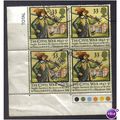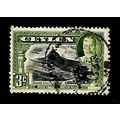Van Gogh, Vincent - Self-Portrait c.1886-7 - art postcard - Used
- Condition : Used
- Dispatch : 2 Days
- Brand : None
- ID# : 200639436
- Quantity : 1 item
- Views : 263
- Location : United Kingdom

- Seller : justthebook (+1703)
- Barcode : None
- Start : Thu 06 May 2021 09:02:59 (BST)
- Close : Run Until Sold
- Remain : Run Until Sold
More Listings from This Seller view all
Seller's Description
- Art Postcard
- Work of art title: Self-Portrait c. 1886-87
- Artist (if known): Vincent Van Gigh
- Media or other details: oil on canvas
- Publisher / Gallery: Art Institute of Chicago
- Postally used: yes - posted to Hastings, UK
- Stamp & postmark details (if relevant): Leicester 1986
- Size: Modern
- Notes & condition details:
NOTES:
Size: 'Modern' is usually around 6in x 4in or larger / 'Old Standard' is usually around 5½in x 3½in. Larger sizes mentioned, but if you need to know the exact size please ask as this can vary.
All postcards are not totally new and are pre-owned. It's inevitable that older cards may show signs of ageing and use, particularly if sent through the post. Any faults other than normal ageing are noted.
Stock No.: A1273
Please ask if you need any other information and I will do the best I can to answer.
------------------------------------------------
Postage and packing charge should be showing for your location (contact if not sure).
UK - PayPal, Cheque (from UK bank) or postal order
I will give a full refund if you are not fully satisfied with the postcard.
----------------------------------------------
Vincent Willem van Gogh (Dutch: [ˈvɪnsənt ˈʋɪləm vɑŋ ˈɣɔx] (About this soundlisten);[note 1] 30 March 1853 – 29 July 1890) was a Dutch post-impressionist painter who posthumously became one of the most famous and influential figures in the history of Western art. In a decade, he created about 2,100 artworks, including around 860 oil paintings, most of which date from the last two years of his life. They include landscapes, still lifes, portraits and self-portraits, and are characterised by bold colours and dramatic, impulsive and expressive brushwork that contributed to the foundations of modern art. He was not commercially successful, and his suicide at 37 came after years of mental illness, depression and poverty.
Born into an upper-middle-class family, Van Gogh drew as a child and was serious, quiet, and thoughtful. As a young man he worked as an art dealer, often travelling, but became depressed after he was transferred to London. He turned to religion and spent time as a Protestant missionary in southern Belgium. He drifted in ill health and solitude before taking up painting in 1881, having moved back home with his parents. His younger brother Theo supported him financially, and the two kept a long correspondence by letter. His early works, mostly still lifes and depictions of peasant labourers, contain few signs of the vivid colour that distinguished his later work. In 1886, he moved to Paris, where he met members of the avant-garde, including Émile Bernard and Paul Gauguin, who were reacting against the Impressionist sensibility. As his work developed he created a new approach to still lifes and local landscapes. His paintings grew brighter in colour as he developed a style that became fully realised during his stay in Arles in the south of France in 1888. During this period he broadened his subject matter to include series of olive trees, wheat fields and sunflowers.
Van Gogh suffered from psychotic episodes and delusions and though he worried about his mental stability, he often neglected his physical health, did not eat properly and drank heavily. His friendship with Gauguin ended after a confrontation with a razor when, in a rage, he severed part of his own left ear. He spent time in psychiatric hospitals, including a period at Saint-Rémy. After he discharged himself and moved to the Auberge Ravoux in Auvers-sur-Oise near Paris, he came under the care of the homeopathic doctor Paul Gachet. His depression continued, and on 27 July 1890, Van Gogh is believed to have shot himself in the chest with a Lefaucheux revolver.[6] He died from his injuries two days later.
Van Gogh was unsuccessful during his lifetime, and he was considered a madman and a failure. He became famous after his suicide and exists in the public imagination as a misunderstood genius, the artist "where discourses on madness and creativity converge".[7] His reputation began to grow in the early 20th century as elements of his painting style came to be incorporated by the Fauves and German Expressionists. He attained widespread critical, commercial and popular success over the ensuing decades, and he is remembered as an important but tragic painter, whose troubled personality typifies the romantic ideal of the tortured artist. Today, Van Gogh's works are among the world's most expensive paintings to have ever sold, and his legacy is honoured by a museum in his name, the Van Gogh Museum in Amsterdam, which holds the world's largest collection of his paintings and drawings.
Van Gogh created more than 43 self-portraits between 1885 and 1889.[249][note 13] They were usually completed in series, such as those painted in Paris in mid-1887, and continued until shortly before his death.[250] Generally the portraits were studies, created during introspective periods when he was reluctant to mix with others, or when he lacked models, and so painted himself.[242][251]
The self-portraits reflect an unusually high degree of self-scrutiny.[252] Often they were intended to mark important periods in his life; for example, the mid-1887 Paris series were painted at the point where he became aware of Claude Monet, Paul Cézanne and Signac.[253] In Self-Portrait with Grey Felt Hat, heavy strains of paint spread outwards across the canvas. It is one of his most renowned self-portraits of that period, "with its highly organized rhythmic brushstrokes, and the novel halo derived from the Neo-impressionist repertoire was what Van Gogh himself called a 'purposeful' canvas".[254]
They contain a wide array of physiognomical representations.[249] Van Gogh's mental and physical condition is usually apparent; he may appear unkempt, unshaven or with a neglected beard, with deeply sunken eyes, a weak jaw, or having lost teeth. Some show him with full lips, a long face or prominent skull, or sharpened, alert features. His hair may be the usual red, or at times ash coloured.[249]
Van Gogh's gaze is seldom directed at the viewer. The portraits vary in intensity and colour, and in those painted after December 1888 especially, the vivid colours highlight the haggard pallor of his skin.[251] Some depict the artist with a beard, others without. He can be seen with bandages in portraits executed just after he mutilated his ear. In only a few does he depict himself as a painter.[249] Those painted in Saint-Rémy show the head from the right, the side opposite his damaged ear, as he painted himself reflected in his mirror.[255][256]
Listing Information
| Listing Type | Gallery Listing |
| Listing ID# | 200639436 |
| Start Time | Thu 06 May 2021 09:02:59 (BST) |
| Close Time | Run Until Sold |
| Starting Bid | Fixed Price (no bidding) |
| Item Condition | Used |
| Bids | 0 |
| Views | 263 |
| Dispatch Time | 2 Days |
| Quantity | 1 |
| Location | United Kingdom |
| Auto Extend | No |




 for 1 item(s)
for 1 item(s)
















